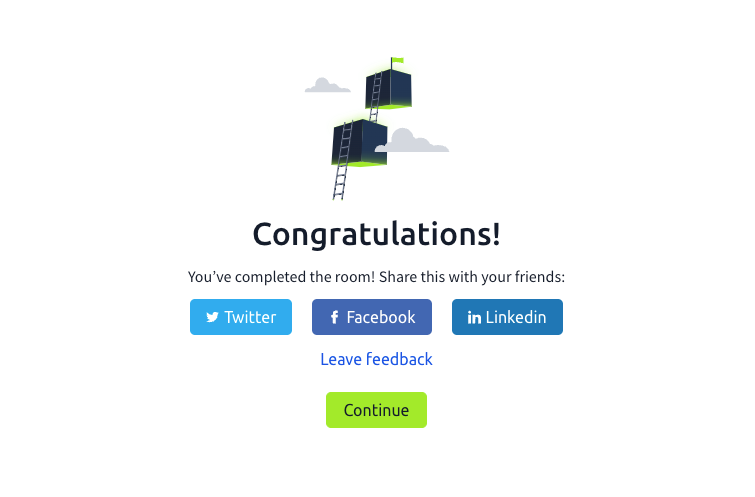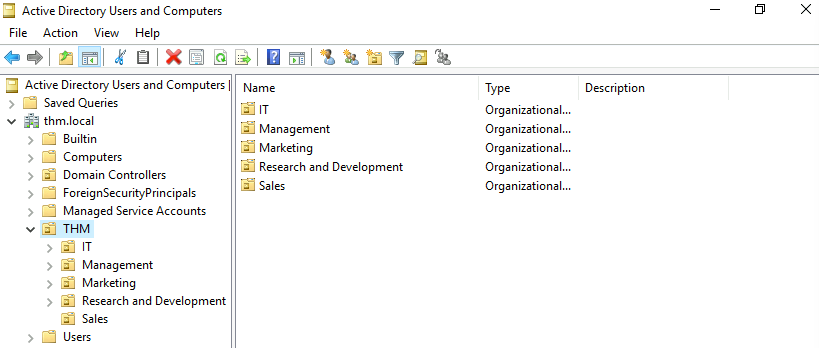
Lab Link: https://tryhackme.com/r/room/winadbasics
This article goes into a walkthrough for the TryHackMe Active Directory Basics room of the Complete Beginner Learning Path.
Task 1: Introduction
In this task, we should launch the Windows server Virtual Machine by clicking on the “Start Machine” button. This will start up a browser-based machine to access the Windows server.
Answer: No answer required
Task 2: Windows Domains
#2.1 In a Windows domain, credentials are stored in a centralised repository called…
Answer: Active Directory
#2.2 The server in charge of running the Active Directory services is called…
Answer: Domain Controller
Task 3: Active Directory

#3.1 Which group normally administrates all computers and resources in a domain?
Answer: Domain Admins
#3.2 What would be the name of the machine account associated with a machine named TOM-PC?
Answer: TOM-PC$
#3.3 Suppose our company creates a new department for Quality Assurance. What type of containers should we use to group all Quality Assurance users so that policies can be applied consistently to them?
Answer: Organizational Units
Task 4: Managing Users in AD
In order to delete an organizational unit within Active Directory, we have to enable Advanced Features in the View menu and uncheck the option “Protect object from accidental deletion” in the OU properties settings. By default, OUs are protected against accidental deletion.
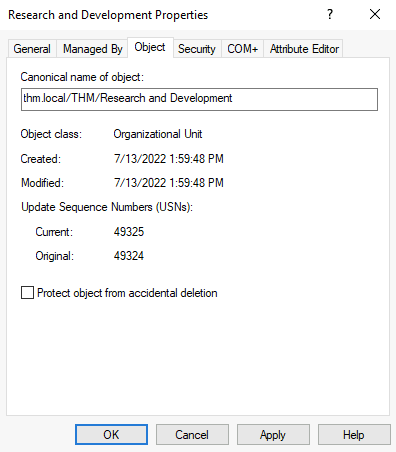
Delegation is the process of giving specific users control over certain OUs. We can delegate control over an OU by right-clicking the OU and selecting “Delegate Control”. For this example, we can delegate IT control on the Sales OU. This will open a window that will ask for users for our delegation and we can type in Phillip for the person we want to delegate control to.

Once you click “Ok”, select the “Reset user passwords” option for the delegation task. Now Phillip should be able to reset passwords for any user within the Sales OU.
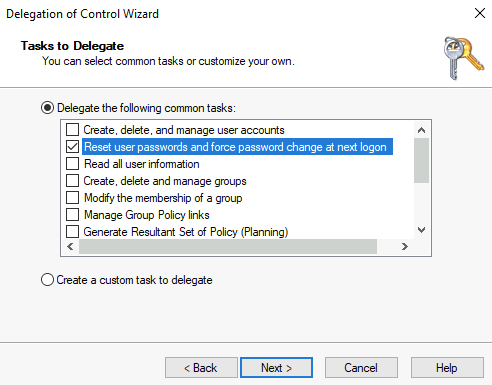
Now we can use Phillip’s credentials to log in via RDP to reset Sophie’s password.


Since Phillip does not have privileges to open Active Directory Users and Computers, we can use the Set-ADAccountPassword command in Powershell to reset Sophie’s password. Since we also do not want Sophie using the same password we set, we can force a password change at login.

When we log in as Sophie via RDP with the new password, we are forced to change the password.
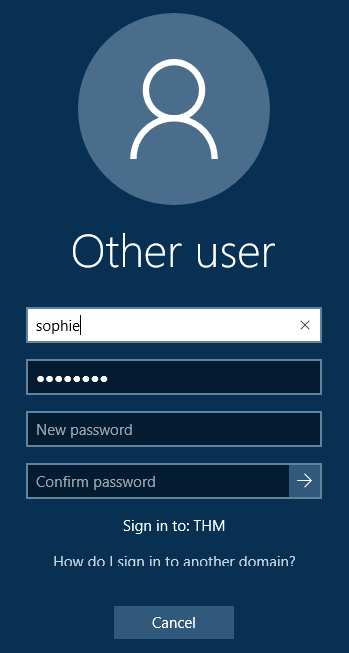
Once logged in, we can see there is a text file with the given flag we are looking for.

#4.1 What was the flag found on Sophie’s desktop?
Answer: THM{thanks_for_contacting_support}
#4.2 The process of granting privileges to a user over some OU or other AD Object is called…
Answer: delegation
Task 5: Managing Computers in AD
By default, all machines within a domain are put in a container called “Computers”. We can see that there are some laptops and PCs corresponding to users on our network. We can create two new OUs, one for Workstations and one for Servers. We can move all the laptops and PCs to the Workstations OU and all the servers to the Servers OU.
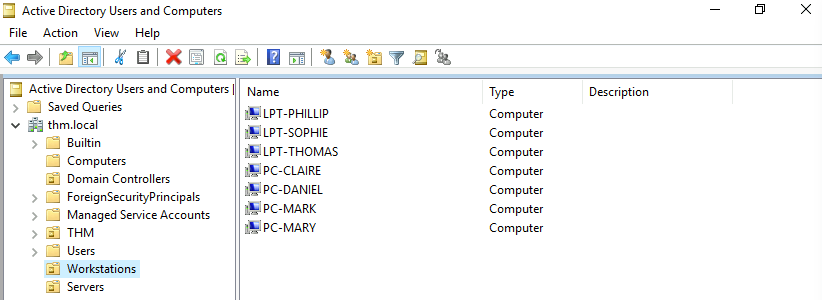
#5.1 After organising the available computers, how many ended up in the Workstations OU?
Answer: 7
#5.2 Is it recommendable to create separate OUs for Servers and Workstations? (yay/nay)
Answer: yay
Task 6: Group Policies
Windows manages policies for different configurations through Group Policy Objects (GPO). GPOs are simply a collection of settings that can be applied to OUs. To configure GPOs, we can use the Group Policy Management tool.

Within each OU, there are different GPOs applied to the users and computers within it. Note that a GPO will apply to the OU it is linked to and any sub-OUs within it. From the Default Domain Policy, we can go to Computer Configurations > Policies > Windows Settings > Security Settings > Account Policies > Password Policy to change the minimum password length to 10 characters.
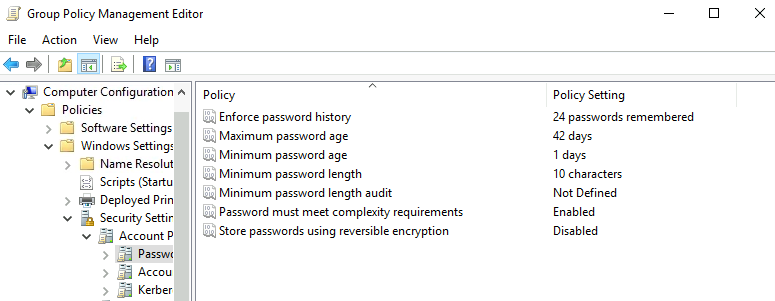
The first task we need to do is to restrict control panel access to users across all machines in our network except for the IT department. We will create a new GPO called “Restrict Control Panel Access” and look under “User Configurations” since we want this to affect all users. We can go to User Configuration > Policies > Administrative Tasks > Control Panel and enable the “Prohibit access to Control Panel” setting.

After creating our new GPO, we can assign the GPO to the Management, Marketing, and Sales OU to have it be applied to all the users in the domain except for IT.

For the second task, we need to have the workstations and servers automatically lock their screens after 5 minutes of user inactivity. We could create a new GPO called “Auto Lock Screen” and apply it to the Workstations, Servers, and Domain Controllers OUs. As a simple alternative, we will apply the GPO to the root domain since they are child OUs of this domain and will be applied to all computers. Within the new GPO, we can go into Computer Configuration > Policies > Windows Settings > Security Settings > Local Policies to change the “Machine Inactivity Limit” to 300 seconds (5 minutes).
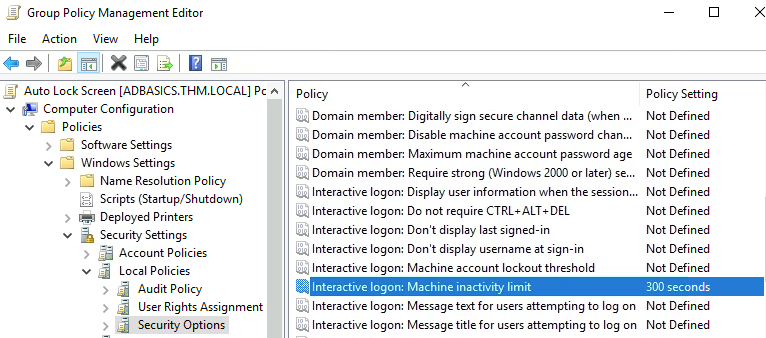
After creating our new GPO, we can assign the GPO to the root domain to be applied to all machines within our network.
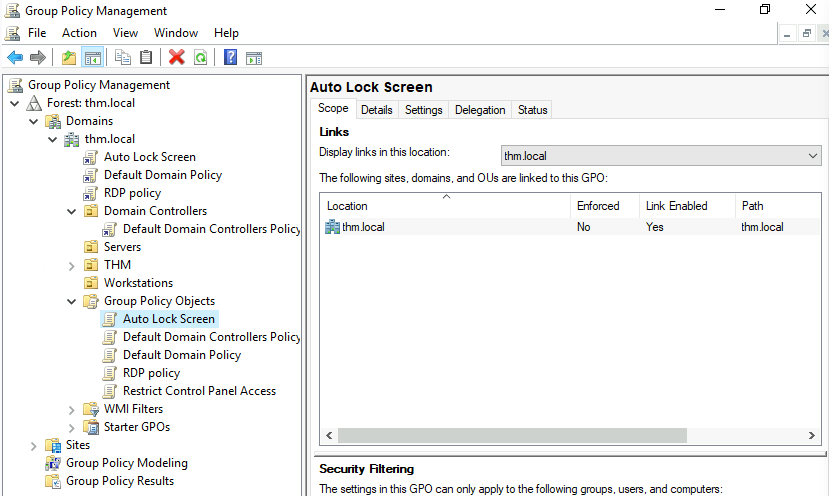
Once the GPOs are applied to the correct OUs, we can log in as any user within the Management, Marketing, or Sales department. We will log in using Mark’s credentials via RDP. If we try opening the control panel we see a restriction message telling us we are denied by the administrator. If we also wait for 5 minutes, we will be logged out automatically.


#6.1 What is the name of the network share used to distribute GPOs to domain machines?
Answer: SYSVOL
#6.2 Can a GPO be used to apply settings to users and computers? (yay/nay)
Answer: yay
Task 7: Authentication Methods
#7.1 Will a current version of Windows use NetNTLM as the preferred authentication protocol by default? (yay/nay)
Answer: nay
#7.2 When referring to Kerberos, what type of ticket allows us to request further tickets known as TGS?
Answer: Ticket Granting Ticket
#7.3 When using NetNTLM, is a user’s password transmitted over the network at any point? (yay/nay)
Answer: nay
Task 8: Trees, Forests and Trusts
#8.1 What is a group of Windows domains that share the same namespace called?
Answer: Tree
#8.2 What should be configured between two domains for a user in Domain A to access a resource in Domain B?
Answer: A Trust Relationship
Task 9: Conclusion
Congratulations! You have completed the Active Directory Basics room.
